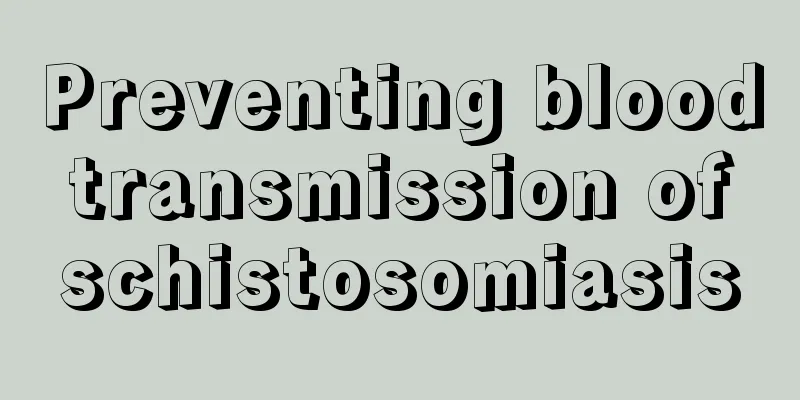Preventing blood transmission of schistosomiasis

|
Schistosomiasis is a relatively common parasite that poses a great threat to human health. Aquatic products can easily breed schistosomiasis. In addition, if you do not pay attention to healthy drinking water, it may cause schistosomiasis to enter the human body, which is relatively harmful to human health. Therefore, it is necessary to prevent schistosomiasis and prevent the blood transmission of schistosomiasis. Let's take a look at this aspect below. Preventing blood transmission of schistosomiasis According to the principle of comprehensive management, scientific prevention and control, and timely and local adaptation to schistosomiasis control, the main measures for schistosomiasis control are as follows: Diagnosis and treatment: Regularly conduct schistosomiasis screening on people who have contact with infected water, and promptly treat those infected. This measure is of great significance for controlling the development of schistosomiasis into chronic and late stages and controlling the source of infection. Preventive medication: In cases of high-frequency and large-scale contact with infected water, preventive medication should be given to people who have been in contact with infected water to reduce the occurrence of "acute cold". Change water and toilets: By connecting to town tap water, using well water or disinfecting river, lake water, etc., we can ensure the hygiene and safety of water and reduce schistosomiasis infection caused by domestic water; use harmless toilets to reduce fecal pollution of water bodies and control the spread of schistosomiasis. Health education: Spread blood prevention knowledge and enhance self-protection awareness through printing brochures, posters, playing CDs, and conducting knowledge competitions. Individual protection: Wear protective equipment (high-top rubber shoes, protective gloves, protective clothing, etc.) during production operations; apply protective medicines (anti-larvae, etc.) to reduce and alleviate infection. Snail inspection and snail eradication: snail inspection and snail eradication in easily infected areas at grassroots stations and construction sites to eliminate the vectors of schistosomiasis. Clinical manifestations It varies according to factors such as the patient's degree of infection, immune status, nutritional status, and whether treatment is timely. Schistosomiasis japonicum can be divided into three stages: acute, chronic and late. When the cercariae invade the skin, some patients develop local papules or urticaria, which is called cercarial dermatitis. When the female worms begin to lay eggs in large numbers, a small number of patients develop acute allergic symptoms characterized by fever, which often appear 1 to 2 months after contact with infected water. In addition to fever, they are accompanied by abdominal pain, diarrhea, hepatosplenomegaly and eosinophilia. Fecal examination shows positive results for hatching of schistosome eggs or miracidia, which is called acute schistosomiasis. Then the disease gradually turns to the chronic stage. In endemic areas, 90% of schistosomiasis patients suffer from chronic schistosomiasis. At this time, most patients have no obvious symptoms or discomfort, and may also be in a subclinical state from time to time, with symptoms such as diarrhea, mucus and pus in the stool, enlarged liver and spleen, anemia and weight loss. Generally, about 5 years after infection, some severely infected patients begin to develop advanced lesions. According to the main clinical manifestations, late-stage schistosomiasis can be divided into three types: gigantic spleen, ascites and dwarfism. A patient may have two or more symptoms. A common clinical syndrome is one characterized by hepatosplenomegaly, ascites, portal hypertension, and varices of the lower esophagus and gastric fundus due to collateral circulation. Late-stage patients may suffer from severe symptoms such as upper gastrointestinal bleeding and hepatic coma, which may lead to death. If children and adolescents are severely infected, the anterior pituitary function may be impaired, and other factors may affect growth, development and reproduction, leading to dwarfism. Because liver fibrosis is often irreversible in the late stage and responds poorly to treatment, late-stage schistosomiasis is clinically difficult to treat. |
<<: Where are women's ovaries?
>>: Capillary blood has the slowest blood flow, which is beneficial to
Recommend
What are the taboos of lemon paste
Lemon paste is a relatively common health food. E...
My face is too thin. What can I eat to make it fatter?
In modern society, people consider small faces to...
What is the identification method for nasopharyngeal carcinoma and how to identify it
For nasopharyngeal cancer, patients must detect i...
Is liver hemangioma serious?
With the increase of life pressure and the occurr...
A full set of tests for lupus or something
Lupus is an autoimmune disease and a particularly...
Is it bad to eat too much seaweed soup?
Nori is a food with a seafood flavor, and its com...
Tips for treating neck pain caused by sleeping with a stiff neck
1. You can directly massage the neck and shoulder...
Will morning sickness still occur if there is no fetal heartbeat or fetal bud?
As we all know, women will have many reactions in...
What are the obvious early symptoms of female thyroid cancer
What are the early symptoms of thyroid cancer in ...
Can drinking pure milk every day help you grow taller? And what should you pay attention to?
Many people have the habit of drinking pure milk ...
Itchy and bloody nose? It turns out that these are the reasons that caused it!
The symptom of itchy nose with blood often occurs...
How to avoid inheritance of esophageal cancer
Esophageal cancer is not hereditary. It is not a ...
10 things you do before going to bed can make you live a hundred years longer
Introduction: As you age, you can no longer be la...
Can the perforation of the eardrum caused by radiotherapy for nasopharyngeal carcinoma be cured?
Patients with nasopharyngeal cancer may have perf...
The dangers of laser armpit hair removal
Sweat hair is an integral part of the human body....









